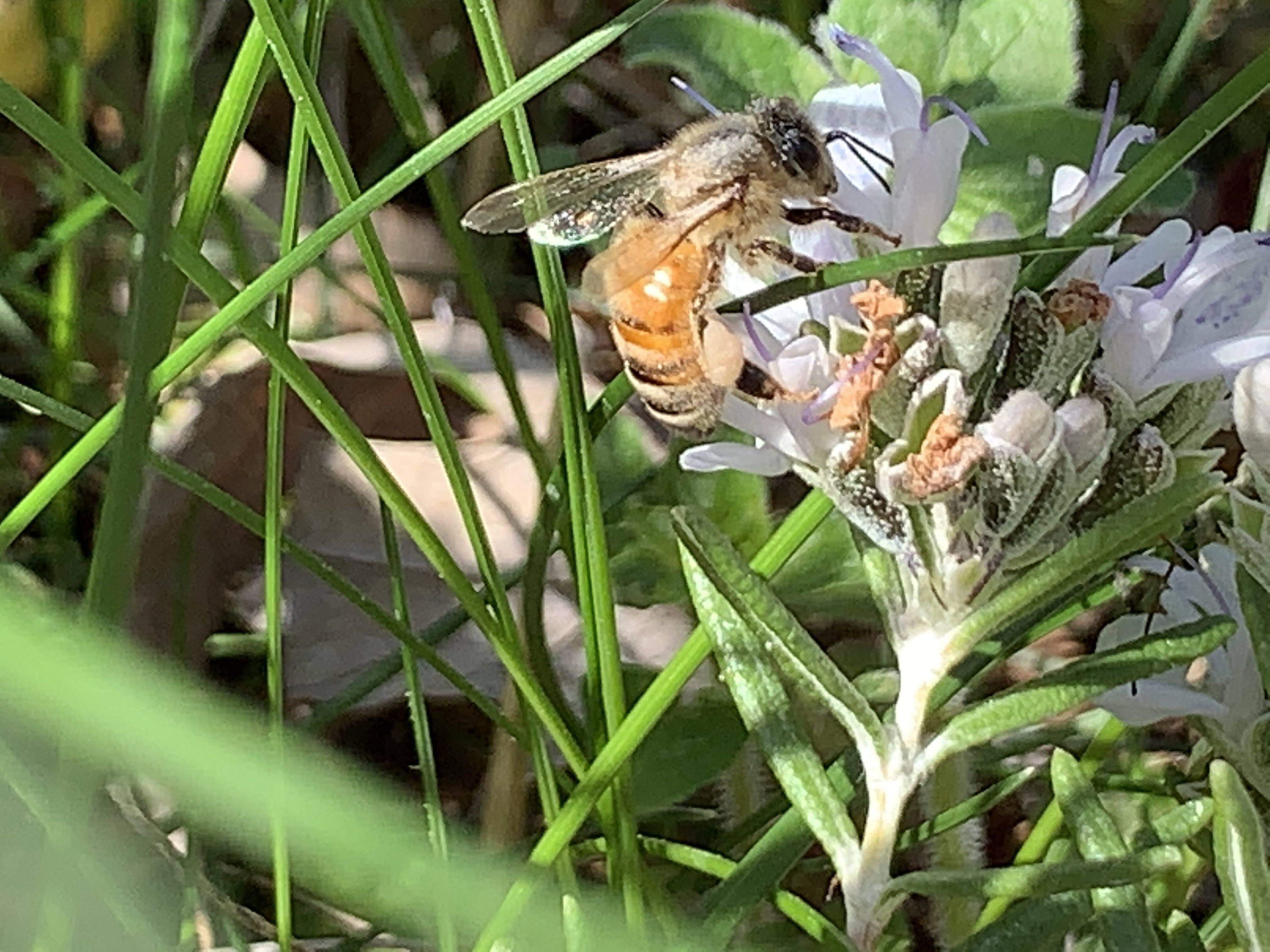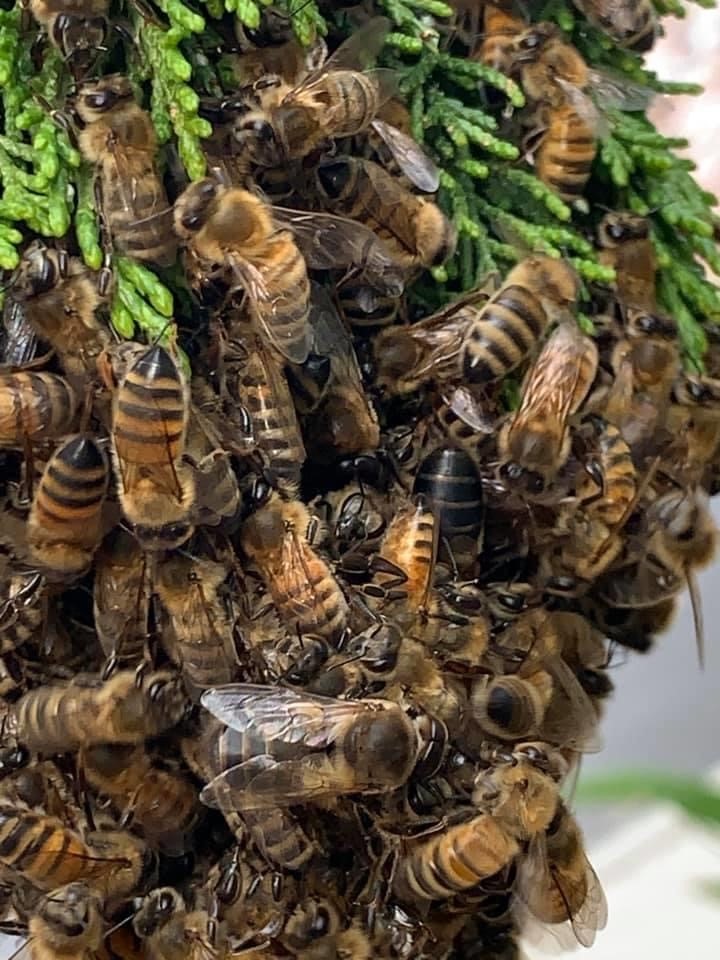
Our agency's mission is to protect land, air, and water for every Washingtonian, and that extends to wildlife and their habitats.
As a community outreach and environmental education specialist for Ecology’s Nuclear Waste Program, I’m usually teaching about cleanup of the Hanford Site. A big part of school outreach is explaining the importance of native versus non-native habitat, plants, and animals at Hanford.
Though not a native species, when a honey bee swarm showed up in my garden, a golden opportunity presented itself to teach children and adults to not be afraid if they ever witness or encounter a honey bee swarm.
What's all the buzz about?
The swarm of bees on a branch, followed by bees entering and leaving a bee box.
My husband discovered the swarm after work, and I quickly grabbed my phone and began taking photos and short videos.
The swarm of bees before being transferred,
With the stay at home order, instead of seeing a handful of people walking in the evening, entire families pass by on foot, bike, and skateboard throughout the day. I waved over a number of passersby to check out the swarm from a safe social distance.
As dusk approached, the swarm, initially hanging from a flimsy branch, began shifting over to the trunk of a shrub. At one point the bees made a bridge of their own bodies so their sisters could crawl from one group to the other. Some bees were still circling and visiting a nearby rosemary bush in bloom. As the sun dropped, the bees slowly settled in and quieted down for the night.
I originally thought I’d let the bees figure out their own course of action. However, several Facebook friends pointed out the bees needed to be put in a hive before they relocated to someone’s shed or chimney. After letting the swarm rest overnight, I called a friend with experience beekeeping to rescue them.
Calling in the beekeepers
I moved outside to begin my work day, sitting on a beach chair in my garden and live streaming the swarm. My friend, Lisa, and her beekeeper mentor, Christina, showed up an hour later with their protective helmets, gloves, and an empty bee box frame.
A beekeeper searching a crowded frame for the queen.
Luckily, the bees were hanging in a beard shape from a branch under which I had been digging out deep rooted weeds. Christina placed the box under the swarm and gently began pushing them into an empty cell in the frame.
If a swarm happens to be on a small branch, the bee keepers can cut the entire branch off and give it a good sharp shake, knocking the bees into the box. However, we had time, and they were hoping to spot the queen.
Queen bee and her nest
This was a slow process, and they never did find the queen. At one point the bees started heading back to the branch, so the ladies realized the queen must have still been in that cluster. Christina scooped a handful gently from the branch, shaking them into the box while Lisa looked for the queen. The others slowly began to follow.
Bees likely protecting their queen on the flimsy branch
The whole transfer from branch to box took about 40 minutes. Early on, many bees were swirling about and their buzzing was very loud, but as they closed in on the box the din decreased. Never once did one land on or even brush against me. They had more important things to worry about.
Once most were in the box, Christina put the lid on and turned it so the opening faced the bees remaining on the branch. Eventually the majority entered the box and she closed the door.
A quick return
I’d long thought about beekeeping, but wasn’t sure I had an appropriate place that wouldn’t cause problems for us or the neighbors. Christina and I did a survey of my property, and she assured me a spot in my back yard would be fine.
She loaded up the bee box and took them home, leaving me time to decide whether they were "my" bees or not. She and Lisa were both very encouraging, saying they chose me.
Knowing how important bees are as pollinators and how threatened they are by climate change and disease, my decision to make a home for them was pretty easy. I figure it complements our work to oversee a safe and complete cleanup, and restoration at Hanford.
Because of the large security zone required at Hanford, only about 10 percent of the site is actually contaminated. That leaves about 520 square miles of reasonably intact shrub steppe habitat. An important part of our work is protecting the site's natural resources and wildlife.
According to the U.S. Fish and Wildlife Service, which manages the Hanford Reach National Wildlife Refuge, there are 1,509 species of invertebrates identified so far at Hanford.
Like the honey bee, native bee populations on the site such as the leafcutter and mason are threatened due to climate change and disease.
The new bee box.
Setting up housekeeping
About $250 dollars and two coats of paint later, I officially became an apiarist, creating a safe space with lots of wonderful forage in my mature neighborhood. My ladies are safe and secure in their new (color coordinated) house. And I’m looking forward to bee-utiful vegetables this year!
Remember, if you spot a bee swarm in your yard, don’t try to spray or disturb them. Visit the Washington State Beekeepers Association to find a local expert who will normally retrieve them for free.
It's also important to recognize not all bees, or things that look like them, are safe. A quick internet search can show the differences in various bees, hornets, and wasps.
Regardless, so long as you respect honey bees and can properly identify them, there’s no reason to bee afraid.
Unbee-lievable facts
- Hives split when they get too big and worker bees can no longer reach the queen. A hive can have only one queen, so the old queen will take off with some of the hive before a new queen hatches.
- Swarms can happen at any time, but are more common in spring.
- Swarms are provisioned only with nectar or honey they carry in their stomachs. A swarm will starve if it doesn't quickly find a home and more nectar stores.
- Scout bees look for a new place to set up a hive, and the swarm may hang out for a few hours, or a few days. About 80 percent of scout bees must agree on the new location.






